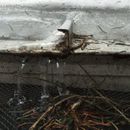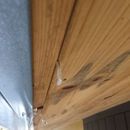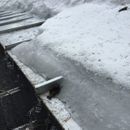Cold climate (6) standing seam metal roof leak
I have concerns my entire roof is leaking due to improper detailing of my standing seam roof. I also think this discussion could help others who might be thinking of a standing seam metal roof. They are not what they’re all cracked up to be. Please look at enclosed photos.
Some details:
I have a shed roof (Structure are I-Joists) with a 3 1/4: 12 pitch. R-60 insulation in cathedral ceiling–“flash and batt.” “Flash” is 4-6″ closed-cell polyurethane spray foam. Hot roof: Fully Zip taped, Zip sheathing and GAF underlayment. And finally: 1″ single-lock standing seam Galvalume.
Conditions:
Lots of snow build-up over winter. Due to the pitch and the amount of insulation, there are no conditions where snow slides off on it’s own. Eventually ice builds-up over top of the seam. As weather gets warmer, water is observed dripping out underneath of overhang (sofit) on low part of the roof. My guess is the entire roof is leaking at the standing seams and water is sheeting down roof plane, over underlayment.
Question:
Will a double-lock fix this problem?
My fear is if I double-lock the seam, I’m committed to the detail and it may still leak. At this point–with a single-lock–I could probably take it apart piece by piece and mitigate the problem. Roofer suggested I clear snow off after every storm–which is not a long-term solution–it’s just plain dangerous. It’s also a “green building” so I’d rather not use heat cables to clear the ice all winter –that would be an admission of failure. I’d like a 50 year solution–which is why I got the metal roof!
Having done some research recently I’ve discovered a 2-3″ tall standing seam with a butyl sealant at every seam would have prevented this from happening. But it’s too late for that.
As it is now, if I can probably take apart the roof–one 30′ section at a time, cover the Zip sheathing with a waterproof underlayment, then re-bend each seam with sealant and a double-lock.
And finally, does anyone think my roofer is at least partially on the hook for my roof leak? He says he’s never heard of this happening before.
Thanks so much for your comments.
GBA Detail Library
A collection of one thousand construction details organized by climate and house part












Replies
One more overall photo:
Those are pictures that are indeed disturbing. From your description it may be that there are leaks in the standing seams. However, it might be premature to jump to that conclusion as there is little corroboration from other owners of those roofs. I'm not saying it's impossible though.
What jumped out at me though is the icecicles in the interior. That would seem to indicate that cold air is bypassing the insulation somewhere. That needs to be investigated. It perhaps is a simple, though not easy to fix, problem of air infiltration past the spray foam insulation where a gap or pulling away has occurred. That might allow warm moist air from the interior to cool and condense on the metal roof and then drip down. Just a possibility that needs to be investigated before jumping to a conclusion.
You still might be right about the leaking standing seams though.
Honestly, low pitch for a metal roof, no matter what the manufacturer says.
This is a crazy winter, and it may not be appropriate to judge a roofs performance by this one winter
My own roof [3/12 pitch, shingles] has drips behind the soffit when serious snow/cold and I have 6 feet of i&w on two different levels. Read that again, feet of ice and water twice.
Sometimes things just are
The only totally water tight solution would be rubber. No sloped roof system is designed to beat ice dams.Person down the street with a 12 pitch roof with tile roof had massive leaks this winter.
It is still a 100 year roof
I would not rip my roof off.
I would consider several lengths of heat cable, to be turned on the 3 days a year they are required
I don't think *any* standing seams are supposed to be a leakproof
component, height or butyl sealant aside. Back up enough water
on them, it's going to go sideways around the inevitable seam gaps
[now or a few years down the road] and get onto the underlayment.
This is why they're not recommended for low pitch; my 4.5:12 shed dormer
is probably close to the limit of what SS can practically handle.
While I didn't have dams per se and didn't see any hard evidence
of it, I'm assuming *some* of the slow melt from the snowpack
on my place did wind up coming down the slip sheet and/or the I&W
underneath, hopefully all safely reaching the edge of the decking
and dropping off under the drip-edge. Nothing indicative in the attic,
where I can see all the way to the top plate and plywood closing off
the chainsaw-retrofit. Well, other than the rafters bending under
the load...
_H*
Thanks for your thoughts. Eric, you came up with a very provocative theory! However it's not warm air infiltrating from the interior. I went over the details too well and the house is tight as can be. But, the 3 foot overhang is uninsulated and the dripping was on the 1st warm day of the winter when roof was melting quite a bit and the ambient outside air was in the 50's and raining. I suppose it's possible it was massive condensation from the ice on the roof hitting the warm, humid outdoor air in the soffit. I would jump for joy if the answer was that simple! Though I now might have to wait until next winter to find out. I'll need to remove a section of the tongue and groove soffit so I can witness the phenomenon.
BTW, closed-cell polyurethane is supposedly waterproof, so I'm pretty sure if water was able to get through the zip sheathing, I may never know if I had a leak inside until down the road, the OSB would start bulging up my metal roof. A scenario I'd sometimes think about late at night. But it's true the leaking was indeed from the soffit and from the metal fascia. Wow, that would be some positive news!
David,
If a new roof is leaking, the roofer is of course responsible.
I agree that this situation is unusual. It is possible that warm, humid air in the soffit is encountering cold surfaces, leading to condensation -- in other words, it's possible that this is not a roof leak.
Hi Martin,
Thanks for chiming in. As a homeowner, this is a difficult situation. There have been studies suggesting the roof could be leaking under these conditions. But there is really no way to tell unless I start removing panels and inspecting. My roofer takes no responsibility for any problems with my roof. And as years go by any recourse I have diminishes. Taking him to court is the last thing I feel like doing. Lesson One when hiring a roofing contractor is go with reputation, not with price. The $3,000 I saved on the installation doesn't seem like much now that I have been having problems.
And this isn't the first problem. Last winter was another banner snowfall winter. The accumulated weight of snow on the roof actually pulled an entire 30' long starter panel down 6"--unbent the crips and all! The roofer didn't fix that either. I had to set up scaffolding and bash the panel back into place and re-crimp it. This winter I was half-way expecting the ENTIRE roof to catastrophically slide off the sheathing. I mean seriously, has anyone tested fastener systems for metal roofs on 1/2 Zip OSB sheathing? It can't be very strong...And 24" of accumulated snow is.
The other house I built has asphalt shingles. It's a 1/3 of the price and headache free.
David,
You need to pay attention to when the leak occurs. If the drips happen on warm days, with ice still on the roof, it's probably condensation. If the leaks happen when it's raining, you probably have a leaky roof.
David: typically, a roof comes with a warranty from the manufacturer of the roofing material. I suggest you contact the manufacturer and see if it will send someone to your house to inspect the roof and determine where the problem lies.